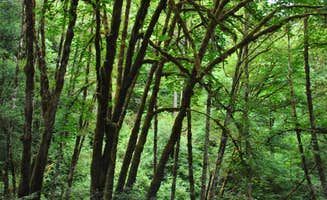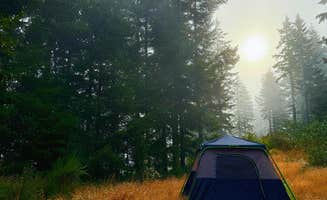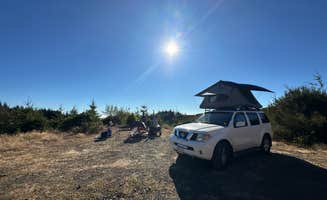Dispersed camping near North Bend, Oregon primarily occurs on public lands within Elliott State Forest, with elevations ranging from 500 to 2,500 feet across varied terrain. The coastal climate brings summer temperatures averaging 65-75°F, while winter months typically see 40-50°F with significantly higher rainfall. Most camping areas require vehicles with adequate clearance due to unmaintained forest roads that become particularly challenging after precipitation.
What to Do
Swimming opportunities: At Elk River "Stony Beach" Dispersed Camping, you'll find crystal clear water ideal for cooling off. One camper noted, "The water is crystal clear and cool, comfortable to stay in for minutes. Had a wild and beautiful romp up the State creek canyon across the bar."
Wildlife spotting: Early mornings at dispersed sites near North Bend provide excellent opportunities to spot local wildlife. At BLM Kentucky Falls Road, campers report enjoying "Birdsongs and gorgeous sunrise in the morning!"
Hiking local trails: Many dispersed camping areas connect to hiking routes through dense coastal forest. "We walked through the creek for a little bit," mentioned one camper at Elliott State Forest, while another stated they "needed a last minute to car camp that was close to the coast" before exploring nearby trails.
What Campers Like
Elevated views: Flat Hilltop Dispersed Site on China Mountain Road offers scenic panoramas from higher elevations. A camper described it as "a pretty large flat top hill with a 360° view, up a short steep gravel driveway. Plenty of room to park and turn around something larger and probably a trailer."
Remote solitude: Many campers value the privacy found at dispersed sites throughout the region. At Elliott State Forest Dispersed, a visitor reported: "Followed Marlow Creek road about 7 or 8 miles straight back until we reached the top of a hill. Cleared out from what looks to be trees that burned from a fire. Makes for amazing views."
Night sky viewing: The minimal light pollution in forest areas creates excellent stargazing opportunities. However, some locations have limitations: "Full time van lifers who work remote. Very dense in a valley spot, starlink would not work great for a work day," noted one camper about connectivity challenges in deeply forested areas.
What You Should Know
Road conditions vary seasonally: Forrest Road 280 near Humbug exemplifies typical access challenges. A camper warned: "About 12 minute slow drive to a very scenic turnout on the hilltop where the area looks to be immediately cleared of trees and large enough to turn around."
Property boundaries matter: Always verify you're on public land. One camper cautioned about China Mountain Road: "This spot and all property off to the sides of China Mountain Road are private property, and there is no trespassing, fires, or camping allowed."
Weather preparedness essential: Coastal fog rolls in quickly, especially at higher elevations. A camper at Flat Hilltop noted: "It got pretty cold and moist at night so keep that in mind. We were able to fit 3 cars easy at our spot."
Limited or no facilities: Most dispersed sites lack basic amenities. "No phone service but the Forest was beautiful!" reported one camper at Elliott State Forest, while another mentioned at Elk River: "People clearly struggle with how to manage the absence of toilet."
Tips for Camping with Families
Select areas with swimming options: During summer months, river camping provides natural recreation for children. At Near Fawn Creek Campground, families appreciate that "keeping them entertained is easy whether it's exploring the outdoors."
Consider road safety: Some forest roads have significant drop-offs or steep sections unsafe for young children. As one camper noted about Elliott State Forest: "This is a logging forest, so we had huge logging trucks roll by in the morning - because of this, it may not be the best spot for kids or off leashed dogs."
Pack extra clothing layers: Coastal temperature swings can be substantial, particularly for young campers. A visitor to China Mountain Road advised: "Plenty of sites, most of which you need to drive up a steep hill. It is a great view, but not much shade."
Tips from RVers
Size limitations matter: Most dispersed sites accommodate smaller rigs only. At Corn Spur Road BLM, campers noted: "Gorgeous views at the end of this road - no official spot but a lovely place to park for a night when campgrounds are full."
Clearance requirements: Standard passenger vehicles may struggle on unmaintained forest roads. One RVer at Forrest Road 280 reported: "Narrow road but I made it up in my 02 Sierra with a 13ft travel trailer. Amazing views and no one around for miles."
Turning radius considerations: Many forest roads lack adequate turning space for larger rigs. As one camper at Near Fawn Creek Campground noted, the spot was "very nice and secluded" but accessibility varies with vehicle size.





